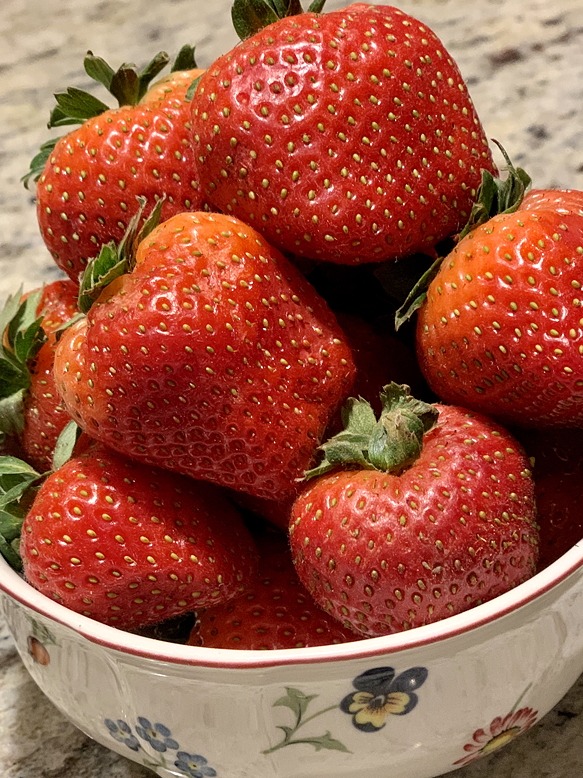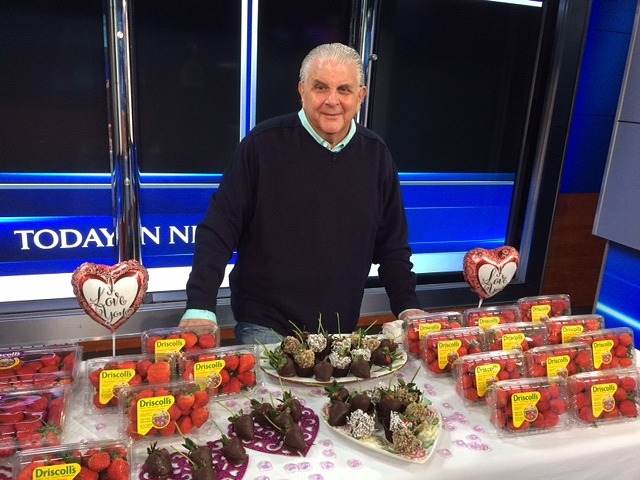
Photo by Susan Bloom
Call me a romantic, but Valentine’s Day and strawberries have held a special place in my heart ever since I was a kid growing up in north Jersey.
One day when I was 16 years old, I went out with a bunch of friends and we met some girls from a nearby town. One girl really stood out to me; her name was Bette Lynn and she was 14 years old. As strange as this seems—because at that age, who knows about marriage or even love?—I told one of my friends that I was going to marry that girl someday. Sure enough, she and I got married in 1967, will celebrate our 53rd wedding anniversary this year, and have two children and seven grandchildren together. I feel lucky and grateful every day to have found that one special person for me.
When Bette and I took over my family’s store, Napolitano’s Produce in Bergenfield, in 1969, we sold roses on Valentine’s Day, but because we were a fruit and vegetable store, we also sold a lot of strawberries.
Stem strawberries were a particularly big seller, especially when Bette made chocolate-dipped ones, because nothing goes better together than chocolate and strawberries. This year, however, berries (and strawberries in particular) have been especially high-priced, largely due to weather conditions. Florida had very warm weather day and night this past October through December, causing the fruit to come on early. Because of the heat, the plants got bigger and started producing less fruit; this was then followed up by rain and cool weather, which stopped the fruit from turning red. At the same time, Mexico and California experienced cool weather, which impacted production there as well, causing an overall shortage of product. The good news is that help is on the way and prices should start falling and quality improving by mid-February.
‘Tis the Season for Strawberries
California produces an overwhelming majority of the nation’s strawberries, providing an almost year-round supply. The California strawberry season begins in January in southern California and continues through November in the northern part of the state, with peak season occurring from April to June. Mexico is another major source of strawberries, as is Florida, where the season begins in December and runs through March.
Strawberries flourish under growing conditions of warm, sunny days and cool, foggy nights. All strawberries are picked, sorted, and packed by hand in the field; the trays of strawberries are then rushed to shipping facilities where they’re cooled down to about 34 degrees Fahrenheit. Within 24 hours of harvest, the strawberries are loaded onto refrigerated trucks for delivery to a store near you.
For Valentine’s Day, long-stem strawberries are an especially quintessential treat. There’s actually nothing different about the biology of a long-stem strawberry versus a no-stem one other than the fact that long-stem strawberries are harvested with the intention of maintaining the structure and integrity of the natural stem the berry grows on and are therefore picked slightly differently. With this variety, the runners coming off the strawberry plant are cut, leaving a long stem on the strawberry, which requires more time in the picking process. The largest and most premium berries are typically the ones picked for stem varieties.
10 Fun Facts About Strawberries
—Strawberries are the first fruit to ripen in the spring.
—One cup of strawberries is only 55 calories.
—Hundreds of years ago, Native Americans crushed strawberries into a mortar, mixed them with meal, and made a strawberry bread. After trying this bread, the colonists developed their own version and the famous summer dessert known as “Strawberry Shortcake” was born.
—Every region has its own unique way of serving strawberries. In Venice, strawberries are served with a wedge of lemon and sugar. In France, strawberries are enhanced with a splash of red wine vinegar. In Greece, strawberries are half-dipped in cheese fondant and served on polished leaves. Here in the U.S., we like our strawberries “as is” or served with whipped cream.
—There’s a museum in Belgium—the Musée de la Fraise de Wepion—dedicated just to strawberries
—Strawberries are a member of the rose family.
—On average, there are 200 seeds in a strawberry.
—Nearly 95 percent of U.S. households eat strawberries and, according to the U.S. Department of Agriculture, the average American consumes 4.85 pounds of fresh and frozen strawberries a year.
—Over half of all 7 to 9-year-olds surveyed picked strawberries as their favorite fruit.
—If all of the strawberries produced in California in one year (one billion pounds!) were laid berry to berry, they would circle the earth 15 times.

Produce Pete discusses the joy of strawberries on Valentine’s Day during a segment on NBC’s Weekend Today in New York. Photo courtesy of Pete Napolitano
Selection and Storage
When selecting strawberries, look for bright, deep red, glossy berries with fresh green caps, leaves, and stems. They should also be dry; look at the bottom of the container and ensure that there’s no seepage or red stains showing. And pass on berries that have turned dull and bluish—they’re goners.
When it comes to storage, the rules are simple: refrigerate, refrigerate, refrigerate! Strawberries are an exception to my general no-refrigeration rule—they must be refrigerated. Strawberries, like most other berries, won’t ripen any further once they’re pulled from the vine, and nothing you can do at home will make a green berry ripen. Once their berry cap is pulled, strawberries will deteriorate very quickly. You can hold ripe strawberries in the refrigerator for a day or two and still have pretty good berries, but the best thing to do is to eat strawberries the same day you buy them.
Preparation
Store strawberries untouched and never wash or remove the strawberry cap until you’re ready to eat the berry. Then just wash the berries with a gentle spray of cool water and remove the caps after the berries have drained. The no-touch rule also applies if you’re planning to freeze the berries. Simply pop them into a plastic bag and put them into the freezer unwashed. Rinse them briefly and remove the caps only when you’re ready to serve them.
Strawberries are delicious raw, on salads or in fruit salad, in muffins or other baked goods, or made into a jelly, sauce, or glaze for cheesecake or other desserts. Another way to enjoy strawberries is to coat them in chocolate and share them with someone you love this Valentine’s Day, which will make the holiday extra special. Hope you enjoy Bette’s recipe!
Bette’s Best Chocolate-Covered Strawberries
Ingredients:
8 ounces semi-sweet chocolate chips (or chips with a higher cacao count if you prefer darker chocolate)
1-pound container of fresh strawberries with stems
Chopped nuts or coconut (optional)
Instructions:
Line a sheet pan with parchment or waxed paper. In a small bowl, melt the chocolate in a microwave at half power for 1 minute, stir, and then heat for another minute or until melted. Holding a strawberry by the stem end, dip into the melted chocolate, letting the excess chocolate drip off. Repeat with the remaining strawberries. If you like, immediately dip chocolate-covered strawberries in either chopped nuts or coconut. Refrigerate immediately until hardened, then enjoy!
(Note: If you intend to dip and garnish strawberries but are unable to find the long-stemmed variety, you can always opt for a quick shortcut and simply pierce your regular strawberries with a toothpick, allowing for a more easily-maneuvered dipping experience).
About “Produce Pete” Napolitano
With over 65 years of experience in the produce industry, New Jersey’s own “Produce Pete” Napolitano is a renowned fruit and vegetable expert, author, and television personality who’s appeared on a highly-popular segment on NBC’s Weekend Today in New York broadcast every Saturday mornings for over 27 years. For more information, visit Pete’s website.
About Susan Bloom
A contributor to New Jersey Monthly and a variety of other well-known local and national publications, Susan Bloom is an award-winning New Jersey-based freelance writer who covers topics ranging from health and lifestyle to business, food and more. She’s collaborated with Produce Pete on a broad range of articles for nearly a decade.



